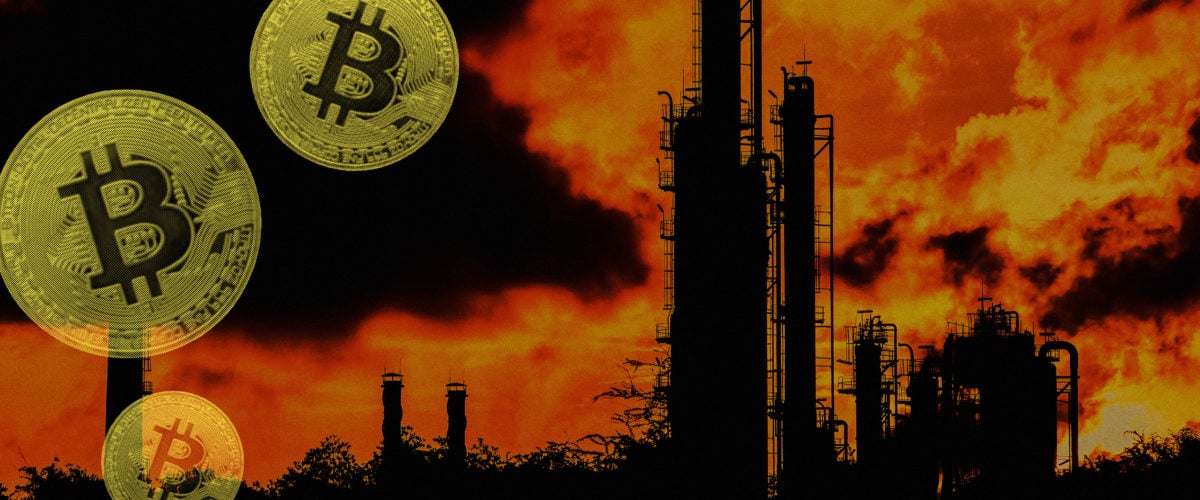Cryptocurrency Is A Catastrophe For The Climate
Published Aug 3, 2022

Energy-hungry, fossil fuel-guzzling, e-waste-churning ... The growing cryptocurrency industry is a disaster for our planet.
Cryptocurrency has taken the digital world by storm, with a single Bitcoin costing $68,000 at its peak last November. Despite recent price drops, many in the industry argue that Bitcoin and other cryptocurrencies aren’t going anywhere.
This promise does not bode well for the climate.
Cryptocurrency creates emissions and electronic waste at massive scales, all while paying fossil fuel corporations to continue drilling and revive dying coal plants. At Food & Water Watch, we know that cryptocurrency is not the solution to the world’s problems. We cannot “build a utopia” on an industry that worsens the climate crisis.
Cryptocurrency Needs Huge Amounts of Energy To Continue Growing
Cryptocurrency refers to digital currency, the most influential of which is Bitcoin. While Bitcoin makes up 44% of the market, there are thousands of crypto options to choose from.
Bitcoin rose as a decentralized currency out of the distrust toward government and banks following the 2008 financial crisis. This is where cryptocurrency’s climate problems begin. Because there are no banks or governments overseeing transactions, the industry developed methods to ensure the security and validity of exchanges. The most popular of these methods, used by Bitcoin and most other coins, is proof of work.
In proof of work, coins are rewarded to the first and fastest computer to solve a complex math equation. Over the years, as competition has grown, cryptocurrency “miners” have needed more and more powerful computers to accomplish this task. Massive data mining centers have sprung up to meet this demand. But crypto mining is an extremely energy-hungry process. Mining a single Bitcoin requires the equivalent of a household’s electricity use over 9 years.
Proof Of Work Chugs Out Emissions Comparable To Whole Countries
With such high electricity use comes high emissions. Research has found that proof of work incentivizes crypto miners to use as much power as possible. For crypto miners to get returns on investments or turn major profits, computers need to run 24/7. This kind of power consumption overextends the grid and emits at scales comparable to mid-sized countries.
Bitcoin uses an estimated 200 terawatt-hours of energy annually, equivalent to Thailand’s energy consumption. This translates to about 100 megatons of carbon emissions per year, comparable to that of the Czech Republic. U.S. Bitcoin mining in 2020 alone emitted 40 billion pounds of CO2.
Crypto Mining Is Creating A New Electronic Waste Market
Electronic waste, or e-waste, refers to electronics like computers or phones that have reached the end of their useful life. Globally, 50 million tons of e-waste is thrown away annually, and only 20% is recycled properly. The rest is tossed into landfills or dismantled by hand by workers in low-income countries, at extreme risk to their health.
We are now beginning to understand how much crypto mining contributes to this. Annually, miners generate e-waste equivalent to that of mid-sized countries. This is because proof of work mining computers, known as application-specific integrated circuits (ASICs), cannot be reprogrammed and serve no other purpose. Once they reach the end of their useful life, they become e-waste.
Additionally, computing power required for proof of work doubles every year and a half. These computers become obsolete within two years. One study estimated that at that rate, Bitcoin mining would produce 10,948 metric tons of e-waste each year. This averages out to 134.5 grams of e-waste per transaction, compared to negligible amounts per VISA transaction.
Crypto Miners Are Teaming Up With Big Oil To Prop Up The Industry
In their never-ending search for cheap energy, miners have started going straight to the source: drill sites and power plants. At drill sites, Big Oil is capitalizing on flaring sell-offs. By flaring, oil drillers burn off excess natural gas that surfaces. They’d rather absorb the $1 billion annual loss than pay transportation and conversion costs.
But now, with eager crypto miners waiting nearby, they don’t have to lose out. Miners park mobile trailers filled with ASICs next to these sites, paying the drillers handsomely to use the excess gas to fuel their operations.
Corporations like Exxon and ConocoPhillips are cashing in on the sell-offs, arguing it prevents flaring and therefore eliminates methane emissions. In reality, it only pads the pockets of Big Oil and incentivizes more extraction. Transferring emissions from one source to another will never solve what we know to be the root cause of climate change: drilling.
Crypto miners are also helping to prop up fossil fuel plants across the country. They partner with floundering, broke coal plants to direct the polluting energy toward mining. After one such partnership in Pennsylvania, a single coal plant’s emissions rose from 12,000 tons in 2020 to 495,000 tons in 2021.
We Need To Shut Down Big Oil’s Collaborators And Support Local Fights Against Crypto Mining
It’s now clear that crypto miners are playing an oversized role in worsening the climate crisis. They’re pursuing profits at the expense of our planet and our future. For these reasons, Food & Water Watch does not accept cryptocurrency donations. We’re also joining the fight against crypto in New York, where communities are rallying for a moratorium on crypto mining collaborations with fossil fuel plants.
From New York and beyond, we won’t let the cryptocurrency industry mine our future for profit. And we won’t let corporations cling to another scheme to keep us hooked on fossil fuels.
More people need to know about crypto’s climate consequences.


FACTORY FARMS MAKE US SICK
Make a gift to ban factory farms ~and have it matched $2-to-$1!
Enjoyed this article?
Sign up for updates.
TO TOP


